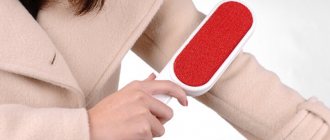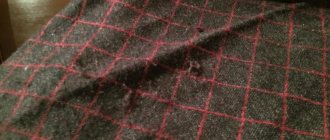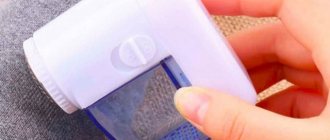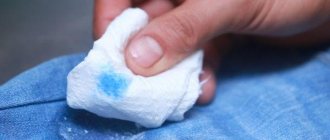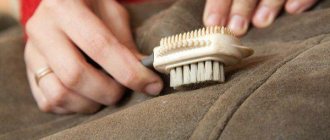Pills on a coat - defective or not
Pills on a new coat are a very common phenomenon. They can appear within one to two weeks after wearing outerwear - becoming covered in pellets is common to almost all products. This fact is depressing, but, unfortunately, it is caused by objective reasons.
It is impossible to say that responsibility for this external defect lies entirely with the manufacturer, just as the opposite cannot be said. The fact is that the appearance of pills is closely related to the natural property of any fabric - pillability.
Pilling is a natural process that produces pills: small balls of wool that form when a material is rubbed.
The ends of the threads become tangled with each other, as well as with fibers that have fallen out of the fabric texture - this is how pellets appear.
Therefore, it is not the fault of outerwear manufacturers. However, responsibility for the use of low-quality fabric in sewing coats, which affects the rate of their formation, falls entirely on the manufacturer.
To reduce the degree of pilling, manufacturers should use the following means and methods in their activities:
- Give preference to fabrics that use artificial profiled fibers - in cross section, such a thread is made in the form of an asterisk, rectangle or triangle.
- Choose fabrics that use threads with long fibers - the latter should hold tightly to the texture of the material, not fall out of it and, as a result, not get tangled with each other.
- Reduce the wadiness of the material by increasing the density of the threads, i.e., when making them, twist them more strongly.
- And finally, use a special fabric treatment - heat setting.
Why do pills appear on my coat?
No matter what measures the manufacturer takes, the appearance of pilling is inevitable, and any coat, be it made of drape, wool or cashmere, one way or another, will lose its original external gloss - it’s a matter of time. At first, the appearance of pilling will be maximum, then, as free fibers fall out of the fabric texture, this process will decrease somewhat. But it won't be possible to stop it completely.
Natural fabrics are less susceptible to pilling. However, pure wool or down is used extremely rarely in making coats. This is mainly due to its shrinkage after washing, and therefore the addition of synthetics is a necessary condition so that the coat does not shrink after wet cleaning.
And if, after tangling pure wool fibers, the pellets fall off naturally, then the presence of stronger artificial threads prevents this from happening - the hair ball will hang securely on the coat on a synthetic “leg”.
Pills appear for one single reason - abrasive effects on the fabric and subsequent tangling of its fibers. Some are less susceptible to pilling, such as cloth, tweed or silk; others - more: polyamide, polyester or elastane. Mixed fabrics, where the ratio of artificial and natural fibers is approximately the same, are classified as highly pillable.
But there are several more reasons that aggravate the coarseness of clothes:
- Violation of the recommendations for wearing a coat - you should not wear your clothes. It is necessary to take short breaks every 1-2 weeks - 24 hours will be enough for the fabric to “rest” and the fibers to straighten out. With frequent use, the material stretches, shorter fibers from the fabric texture “come out” and become tangled.
- A backpack and a coat are incompatible. Avoid sharing these items. Suede bags also negatively affect the fabric - they wear it out.
- Improper coat care. If the clothing label allows it to be wet cleaned at home, never use detergents or machine wash - only mild detergents and gentle hands.
- Storing a coat in the off-season also affects its appearance - use special covers - no contact with other clothes.
Causes of pilling on clothes
Why do pills appear on fabric? First of all, the origins of the problem should be sought in the composition of the fabric. Natural fibers tend to be amenable to abrasion and thread twisting. Synthetic materials suffer from this “disease” much less frequently, especially if they are properly prevented with special chemicals. If we talk about proper laundry care, you should pay attention to the drying process. Fabrics that do not tolerate heat treatment well must be dried in a special way. It is forbidden to use an iron to smooth them. Areas of clothing that constantly rub against something are susceptible to frequent pilling. So, on a sweater, the area under the armpits can be considered a “sore” spot, and on trousers – at the painful points.
When to sow and harvest Lupine, planted as green manure to improve soil fertility
Features of cleaning spools for different materials
There are only two methods for removing pellets from fabrics:
- cutting off the “leg” of the spool;
- removing the pill by breaking it off.
For each type of fabric you need to choose your own cleaning method:
- The drape material is very dense and durable. The pellets can be cleaned using any convenient method: cutting or tearing off the pellets. To do this, use hard brushes, scrapers, razors and special trimmers. The risk of damaging the fabric is minimal.
- Cashmere requires delicate care, so cutting tools are not suitable here. A soft toothbrush or other similar device is more appropriate. A roller with adhesive tape will also help remove pellets - it can and should be used for daily dry cleaning of cashmere.
Wool is often used to sew textured coats. The long fibers and coarseness of the product require the use of nail scissors or textured hard sponges, which are used for cleaning suede. The method with scissors, although risky, is the most flexible - you can remove the pellets in the most inaccessible places. But a suede sponge allows you to get rid of pellets in a matter of minutes. These two methods complement each other perfectly.
How to clean a coat from pellets at home: from folk to professional methods
Razor
The procedure is very simple: armed with a razor, carefully run it from bottom to top across the fabric, very carefully cutting off lumps.
Despite its availability, this method can be dangerous due to the lack of necessary skills and non-compliance with instructions. How to remove pellets from a coat at home with a razor:
- the razor must be old and dull enough (too sharp blades can irreversibly damage fragile material);
- Before processing, the fabric must be stretched well and kept “tight” all the time;
- The method is only suitable for smooth, dense fabrics without texture, but in no case should it be used for cashmere, mohair or angora.
Duct tape
If lumps have just begun to appear, regular tape or adhesive tape will help fight them. An important condition is that the device must be really very sticky, so if you only have very old tape lying around at home, it is better to go and buy a new and more durable one. The process itself is very similar to depilation: you stick a strip on the fabric, press it firmly with your hands, and then tear it off with a sharp movement from the bottom up.
Life hack: if you don’t have adhesive tape at hand, a wide patch or wool roller can help out.
Comb
If you have a comb with very fine, short teeth, you can also use it to care for woolen jackets. Just comb the fabric along the fibers 2-3 times.
Remember: the more carefully you remove the lumps, the less of them remain on the fabric. The same adhesive tape or razor will help remove the residue.
Toothbrush
Rub the fabric, moving from top to bottom along the fibers of the fabric until all the pellets are gone.
Important: this device is only suitable for fabric with a long pile.
Scissors
This is labor-intensive, but the method eliminates pellets. It is almost impossible to damage the material if you are careful.
Remove lumps as follows:
- First, the fabric is placed on a hard work surface and stretched well;
- then it is advisable to comb the pile using a comb or toothbrush;
- After that, each lump is slowly and carefully cut off with nail scissors.
Important: this method is best suited for cleaning large pellets in a small area when they have just begun to appear.
Sandpaper
For a smooth, lint-free coat, you can take fine-grained sandpaper and work the surface well with it. The method prevents the defect from appearing for a long time, but be careful: if you press too hard, you can damage the fabric. If you use it frequently, the material may become thinner.
Hard washcloth
A simple way to get rid of pilling on your coat. Buy a new, hard washcloth and start dry processing. To do this, moving in the direction of the fibers, move the washcloth over the fabric for several minutes. There is no need to wet it or the material.
An alternative tool is the hard side of a new dish sponge.
Stale bread
If you don’t have a washcloth or sandpaper, you can prepare their equivalent at home from a piece of black bread. Take a thick piece, preferably from the crust side, so that it crumbles less. Then toast it well in the oven or toaster so that you get a very hard cracker, and start processing.
How to clean a coat from pellets
There are quite a lot of ways to remove pellets from a coat. The inquisitive human mind created not only a special tool, but also adapted various improvised devices for this. All of them have proven themselves to be excellent, although they need to be used correctly and for specific tasks. Using scissors or a razor to remove pellets from cashmere is not wise, nor is using tape to remove pellets from wool material.
Razor - the cleanest fabric processing
Another use of a men's accessory. Do not rush to throw away dull razor cassettes - they can be used in the “fight” with pellets. This is the first remedy when cleaning draperies. The sharpness of the “old” blade is enough to cut off the “legs” of the pellets. The appearance of the coat will again acquire its original appearance.
However, be careful when working with a razor; the risk of damaging your coat is high. Move the machine slowly, without sudden movements, only along the pile. For the best effect, the coat fabric must be kept taut.
The best results are produced by single-edge razors from Soviet times. They make it possible to adjust the height of the blade - the smaller the angle between the razor and the coat fabric, the more fluffy the material can be cleaned.
Suede shoe sponge - the fastest way to remove pills from a wool coat
This method is recommended for owners of textured wool coats. The suede sponge is ideal for removing large pellets. This method is the fastest. Combing wool fabric is easy and quick, and the quality of the result is amazing.
This sponge is made of a tough material, but soft enough to be used on very fleecy fabrics. The relief shape allows you to remove pellets of various sizes from the most complex relief textures. To remove pills, just run the sponge over one place once or twice, and they will all remain on the porous surface of the device. The appearance of the coat can be restored in just 5–10 minutes.
Unfortunately, this method is not as effective with tightly woven fabrics.
Toothbrush – gentle and effective cleaning of coats
If the coat does not tolerate harsh mechanical cleaning, then you can use a toothbrush with soft bristles. It is convenient to hold it in your hand and handle the surface of delicate fabric. Brush only in the direction of the fibers, systematically combing out the pile.
The work is labor-intensive, but not as much as removing pellets with nail scissors. To increase productivity, you can use clothes brushes - the main thing is to choose the right stiffness of the bristles.
Sandpaper is the cheapest and most effective way to clean draperies.
Who would have thought, but this method will allow you to quickly get rid of pills on tightly woven fabrics, spending only 30–40 rubles.
In terms of processing speed, this method is comparable only to cleaning clothes with a sponge for suede shoes - the same 5-10 minutes. Allows you to quickly and reliably remove pellets at home.
Buy paper with a fine abrasive – coarse sandpaper will not work. Also, you should not buy an abrasive for polishing - it is not able to capture tangled fibers.
Manicure scissors - cheap and practical
Removing the pellets with nail scissors allows you to completely control the coat peeling process. There are no hard-to-reach places for scissors. Used to remove pellets from fleecy fabrics.
However, this is a very labor-intensive job that takes a colossal amount of time. Therefore, use scissor cutting only for small amounts of work.
Penza - mineral “cracker” for removing pellets from synthetics
Artificial fibers are distinguished by their strength. It is difficult to remove such pellets, because they are securely held on synthetic “legs”. You won’t be able to tear them off with a brush; cutting them off with a razor is risky—a stone for foot hygiene: Penza will help you cope with this task.
The porous structure of this mineral allows you to reliably cling to the pellets and tear them off the surface of the coat. In this case, the tissue is practically not injured. Removing the pill is easy and quick.
Stationery tape – delicate dry cleaning
This method is not universal. It is suitable for cleaning coats made from natural raw materials: sheep wool or goat down; In this case, the fabric can only be tightly knitted from highly twisted threads. In other cases, this method is useless.
Glue a strip of tape onto the surface to be treated and pull it away from the fabric with a sharp movement. The pellets and other hair debris will stick to the tape. This method is suitable for daily dry cleaning of coats, although in this case it is better to use a sticky roller made specifically for this task.
A clothes trimmer is the easiest way to get rid of pellets.
A special machine for cleaning clothes from pellets is simple in its design: a housing with an electric motor, a fan, sharp blades, a protective mesh and a trash compartment. It is very effective and functional: in many models the blades are adjustable in height, which allows the machine to be used for processing various textures.
It is easy for her to work - this is the simplest way. You just need to set the required height of the razor blades, connect it to the mains if it is not battery-powered, and start cleaning. It takes little time to process the coat: 10–20 minutes will be enough.
If you have chosen a clothing trimmer, then buy two of these machines at once, with different protective nets. Use one with large holes to remove large pills from wool clothes, and another with smaller holes to remove small pills.
Cotton.
Cotton symbols: algodon (Spanish), cotton (English), baumwoole (German).
Cotton fabrics include: chintz, denim, cambric, calico, pique, poplin, voile, rosin, teak, percale, nansook, organdy.
You may hear the words mercerization, mercerized cotton. Mercerization is a special treatment of fibers with caustic soda (sodium hydroxide alkali). Gives fabric shine, prevents fading, increases strength. To prevent a cotton item from wrinkles, the fabric is treated with urea-formaldehyde or melamine-formaldehyde resin.
I'm your baby. Portal for loving parents || Bathing your ferret at home. How to bathe a ferret at home How to train a ferret to take a bath
Natural fabrics shrink, remember this when caring. Read and follow the instructions on the product label.
Additional recommendations
All the methods discussed will help you clean your outerwear from external defects. This procedure is not a one-time procedure; it will have to be performed repeatedly throughout the season. All this negatively affects the condition of the tissue, since the mechanical impact injures it. To protect your coat from premature wear, you need to reduce the pilling process.
How to treat a coat to prevent pilling
To make the fabric fibers less likely to pill, you need to treat the coat with an antistatic agent. As the latter, you can use food vinegar, adding it when washing or when rinsing a coat. It not only gets rid of static charge, which is a catalyst for increased pill formation, but also neutralizes detergent residues well, softens fabric fibers, and also preserves the original color of the product. For rinsing, it is enough to add about 200 ml of this product.
There are no special means to prevent the appearance of pellets - it is impossible to completely prevent their appearance. You can only wear and maintain the item correctly - this is a guarantee that it will serve for many years: at least 3-5 seasons.
How else to prevent the formation of pilling on your coat
It is impossible to completely prevent the formation of pills on outerwear. However, it is quite possible to reduce the pilling process. To do this, it is necessary to eliminate the factors that injure the fibers when wearing and maintaining the coat:
- strictly follow the manufacturer’s recommendations for cleaning, washing and storing outerwear;
- do not use machine wash, even if it is allowed;
- wash only in warm water;
- do not use crystalline powders - only gels, shampoos and conditioners for delicate washing;
- Do not wring out your outerwear by twisting it - the water should drain on its own;
- do not dry the product near heating devices;
- It is not recommended to iron a coat; if ironing is allowed, then only through gauze or cotton cloth;
- do not drag your coat - alternate outerwear if possible - let it “rest”.
And lastly, if you are not confident in your abilities or doubt the choice of one method or another, then it is better to contact a dry cleaner. Although this is expensive, the safety of your favorite thing and your own peace of mind are more valuable.
